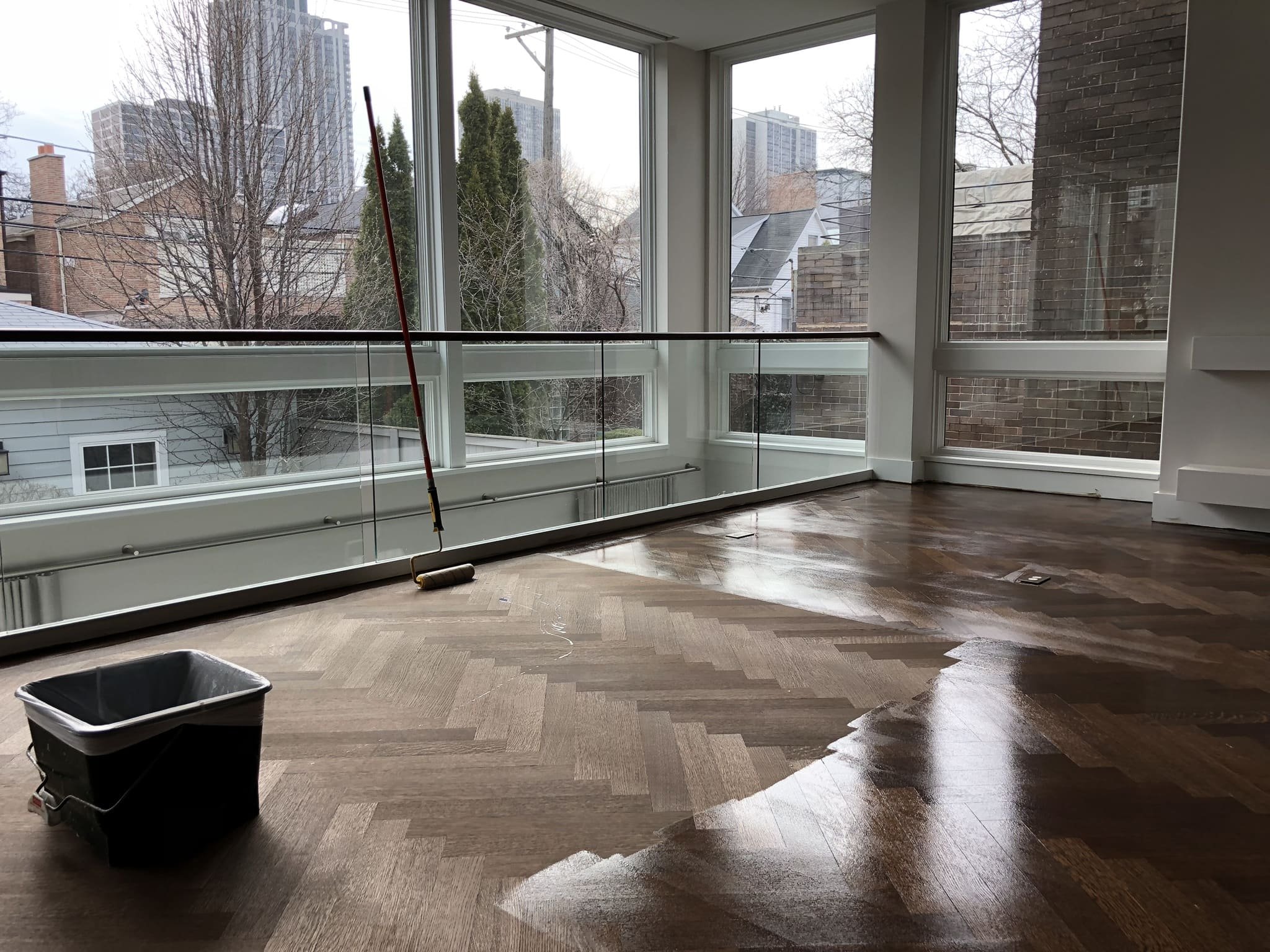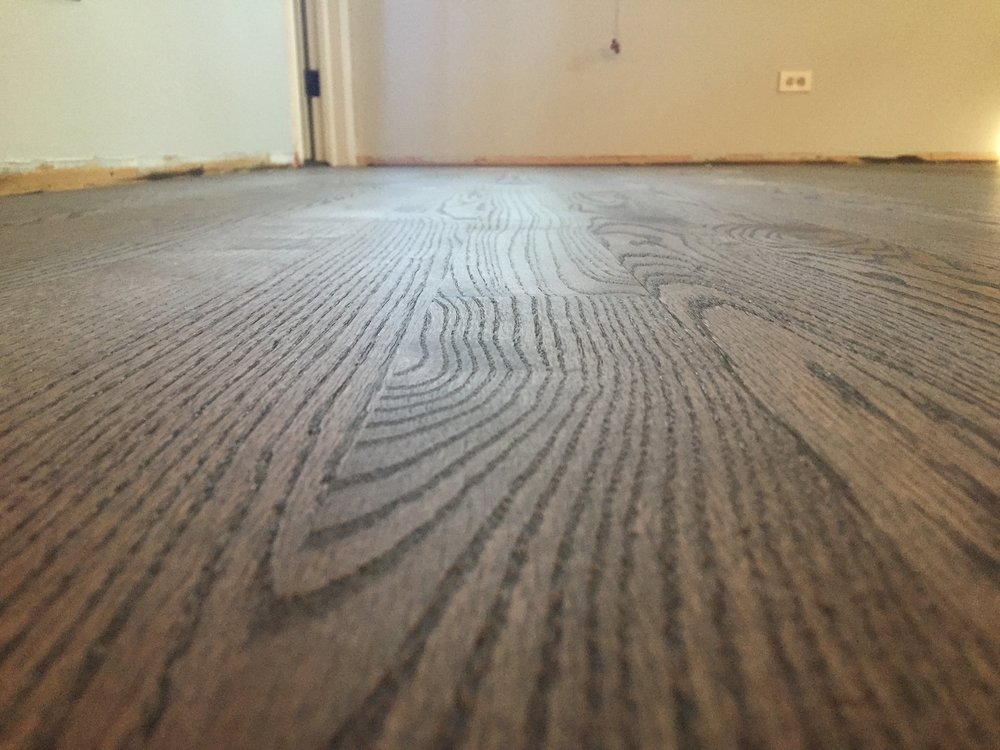Rubio Monocoat and standard oil\water based finishes are both very popular options for hardwood flooring, but they have different properties and characteristics. Learn about the differences and benefits of Rubio Monocoat vs a standard finish in our newly updated post.
The Pros and Cons of Stained Floors
Having a Hardwood Floor Installed? Here's What to Expect
White Oak vs. Red Oak: The Flooring Facts
Water Based Finish vs Oil Based Finish: Myths and Comparisons
Why Hardwood Flooring is a Much Better Choice Than Laminate
Nothing can add to the aesthetic appeal of a room like a good floor, and when it comes to flooring nothing quite matches the appeal of wood. For many homeowners and designers alike, a wood floor is the mark of true quality and can increase a home’s value dramatically.
Because hardwood flooring can be expensive, many people choose laminate instead. However, in most cases it’s not the best choice. Let’s take a look at some of the reasons why you should always opt for hardwood.
Composition
One of the easiest ways to see the benefits of hardwood over laminate is by looking at the composition of both. Hardwood flooring, as its name suggests, is made up of individual planks cut from a larger piece of wood and then milled to their final size and shape. In general, hardwood planks are three-quarters of an inch thick, giving them much more substance than laminate. Since they are made from one solid piece of wood, hardwood planks are sturdier and more substantial, meant to last a lifetime.
The composition of laminate is more complicated, involving several layers, the thickest of which is a core made of fiber board, a much flimsier material than wood. Surrounding that core are several different layers meant to simulate the look of wood, provide waterproofing and guard against scratching. Not only does this make laminate less substantial than solid wood, but it can also lead to other dangers from the various chemicals used to treat it.
One of those chemicals, formaldehyde, has been the focus of much controversy in recent years. Lumber Liquidators, one of the largest flooring retailers, became the subject of a lawsuit when it was determined that some of its laminate flooring, which had been manufactured in China, contained dangerous levels of formaldehyde.
Scientists have proven that prolonged exposure to fumes from formaldehyde can lead to serious health issues and may be particularly dangerous for individuals who suffer from respiratory ailments like asthma. Lumber Liquidators stopped carrying the flooring in question in response to the suit but the case definitely brought much needed attention to the potential dangers of the chemicals used in manufacturing laminates.
Installation
Another key area of difference is installation. With specialized seams that click together, one of the main selling points of laminate flooring is that it is easy to install. While this is generally true, the tight connection of laminate boards can be troublesome as it doesn’t allow for the natural expansion and contraction that happens over time.
Most hardwood flooring is made with tongue and groove or shiplap design, allowing the boards to overlap but also allowing room for the wood to breathe, which makes it more adaptable to expansion and contraction. At the same time, prefinished hardwood often comes with edges that are slightly beveled at the top of the plank. When they are connected, this beveling leaves a small V shape between the boards, which adds an extra sense of dimension to the overall look, making it more aesthetically pleasing.
Finish
In terms of design, the finish of a wood floor is probably the most important quality of all and once again, there is a distinct difference here between hardwood and laminate. Laminate flooring is manufactured with what is called a photographic layer, which is embedded with a photographed image of stained wood. By using different types of woods and different colorings, you can find a laminate to match any room design. Likewise, there are prefinished hardwood planks that come already stained and sealed in a variety of colors and styles.
For designers and homeowners who want to customize to their taste, using unfinished hardwood can provide an even more desirable option. Since these planks come without any stain or finish, they can be customized to your liking to fit a specific design style. While this involves the extra work of staining and sanding, to many people it is well worth the effort to get the exact look they want.
Durability
As anyone who has ever lived with a wood floor knows, damage is a fact of life. It’s nearly impossible to escape the occasional dent or ding or spill and depending on the location of a room, fading from the sun may be an issue over time too. With all that in mind, you can’t easily deny the durability of hardwood. Again, as the name suggests, it is hard and that helps it to stand up to the test of time. Hardwood floors are made to last, which is why most realtors consider them one of the biggest assets of any home.
This doesn’t mean that they can’t be damaged. High traffic areas will eventually show wear and tear and dropping an item on a hardwood floor can cause a ding, but these common issues can be more easily repaired with hardwood than laminate. A simple sanding and buffing will usually be all that is needed, while individual planks may need to be replaced when laminate becomes damaged.
Of course, the one threat that even durable hardwood can’t always stand up to is water. Water damage can cause expansion and buckling with hardwood floors, which can become both an eyesore and a tripping hazard. In areas like basements, kitchens and bathrooms, where contact with water is more common, laminate is generally the preferred choice as it doesn’t stain as easily.
You can protect against water and humidity issues by choosing wood of a higher quality that will stand up to water better and by allowing wood planks to acclimate before installing by leaving them in open boxes at the construction site for several days before installation. Even with acclimation, however, water will always remain a major concern with any kind of wood flooring.
Bottom Line
While hardwood flooring can be more costly and more difficult to install, there is no comparison when it comes to durability and the warm, natural feeling of wood. Though the manufacturers of laminate have made great strides in providing a product that approximates the look of wood, the reality of laminate is that it is less durable and has a more artificial look as well as containing potentially harmful chemicals that could adversely affect your family’s health.
Not only can you customize untreated hardwood with your own choice of stain, allowing it to match any design aesthetic, as a natural, chemical free, product it is the safer option by far. The beauty, durability and safety of hardwood speak for themselves. Taking all these factors into account, it is easy to see why hardwood is by far the better choice.
Rubio Monocoat - Rustic is the New Sleek
If you’re discussing flooring options with a Chicago floor refinishing company, something you may want to consider is Rubio Monocoat. This floor refinishing option offers many advantages, both in its unique appearance as well as its durability.
Rubio Monocoat is also a safer and more environmentally sustainable choice for your home. So as you consider all of your hardwood floor refinishing options, let’s see if a Rubio Monocoat floor is the right choice for you.
What is Rubio Monocoat?
Rubio Monocoat is one of the newest floor refinishing options out there. Unlike typical stains that get painted onto the top of hardwood flooring, Rubio Monocoat is a plant-based hard wax oil finish. A Rubio Monocoat finish will penetrate deeper into the wood, creating what is called a “super matte” finish that is quite unique.
It is also much more environmentally sustainable than other flooring stains since it is plant-based. Moreover, it also does not emit any volatile organic compounds (VOCs) either, another benefit of this new, high-tech hardwood floor refinishing option.
Why Rubio Monocoat May be a Great Choice for You
One of the best reasons to choose a Rubio Monocoat floor is because of its beauty and uniqueness; there is truly nothing else out there that looks like a hardwood floor refinished in Rubio Monocoat. The rustic yet sleek appearance of a hardwood floor with hard wax oil applied to it can really add the Wow Factor to your home.
Additionally, if you’re concerned about the environment and the safety of the hardwood floor refinishing options you’re considering, there is no better choice than Rubio Monocoat. Finally, if you’re focused on things like your home’s resale and property value, it is hard to argue against this high-tech hard wax finish.
Rubio Monocoat is new, however, so it can be challenging to find floor refinishing companies in Chicago that are using it. Consider contacting companies like Hardwood Flooring Glencoe or Lakewood Floor Refinishing, or find another reputable company that is ready to work with the product. Once you find a good hardwood floor refinishing company in Chicago that is familiar with Rubio Monocoat, you’ll be ready to take the flooring in your home to the next level!
Hardwood vs. Softwood Flooring: What is the Difference?
4 Types of Hardwood Flooring and When to Choose Each
3 Ways Hardwood Flooring Adds Value to Your Home
Chicago Neighborhoods, a Hardwood Flooring Perspective
Rubio Monocoat: High-Tech Wax from the Future
In the world of hardwood floor contractors, Rubio Monocoat is a buzzword that is thrown around a lot these days. A Rubio Monocoat floor is comprised of a hardwood floor oil finish that has unique visual and durability properties. Created through applying a special blend of natural oils and waxes that bond to the wood from the inside, Rubio Monocoat floors form a watertight coating that is very durable. The color choices are incredible as well with 40+ inter-mixable colors; there are many mixes available to make virtually any look you can dream up possible.
Refinishing vs Replacing Hardwood Flooring
Hardwood flooring, while durable, still wears from years of heavy use. There comes a time when every homeowner with hardwood must make an important decision: to refinish or replace their hardwood floors. Keep reading to discover the pros and cons to each, and what to look out for when choosing hardwood floor refinishing contractors.





















